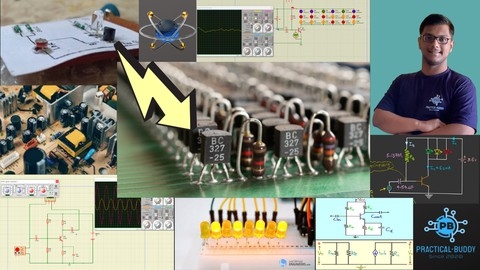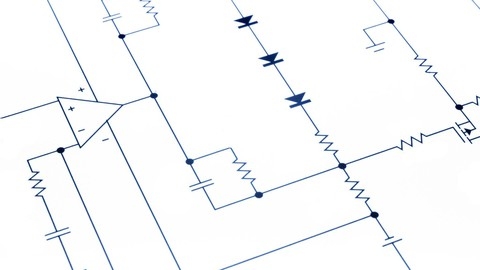Analog circuits are the foundation of many modern electronic devices, from smartphones and computers to medical equipment and industrial controls.
Understanding analog circuits is essential for anyone interested in electronics engineering, hardware design, or even just a deeper understanding of how the world around us works.
Learning about analog circuits can open doors to exciting career opportunities, allowing you to build, design, and troubleshoot complex electronic systems.
Finding the right course to learn about analog circuits can be overwhelming, with a vast array of options available on platforms like Udemy.
With so many choices, it’s easy to feel lost and unsure where to start.
For the best analog circuits course overall, we recommend The Complete Electronics Course 2024: Analog Hardware Design on Udemy.
This course is highly rated for its comprehensive coverage of analog circuit fundamentals, its engaging teaching style, and its focus on practical applications.
It covers everything from basic concepts like voltage, current, and resistance to more advanced topics like operational amplifiers, filters, and power amplifiers.
This is just the tip of the iceberg, though.
We’ve also curated a selection of other fantastic Udemy courses specifically designed for analog circuit enthusiasts, ranging from beginner-friendly introductions to advanced topics for experienced engineers.
Keep reading to discover the best analog circuits courses on Udemy to jumpstart your journey into the fascinating world of electronics.
The Complete Electronics Course 2024: Analog Hardware Design
Best Udemy course for beginners looking to master analog hardware design fundamentals.
You will start by learning about the history of electricity and how it led to the development of electronic devices.
The course then dives into the basics of electricity, including atoms, electric charge, conductors, and insulators.
Next, you will learn how to use a circuit simulator, which is an essential tool for understanding and designing electronic circuits.
The course covers the fundamentals of voltage, current, resistance, and Ohm’s law, as well as direct current (DC) and alternating current (AC) circuits.
You will then explore various electronic components, such as resistors, capacitors, inductors, diodes, and transistors.
The course explains how these components work, how to calculate their values, and how to use them in circuits.
You will also learn about Kirchhoff’s circuit laws, which are essential for analyzing and designing complex circuits.
The course covers several important topics, including electric power, filters, radio and signal modulation, and various types of circuits, such as rectifiers, amplifiers, and oscillators.
You will also learn about operational amplifiers (op-amps) and their applications in arithmetic circuits, precision rectifiers, and other common circuits.
Additionally, the course covers linear voltage regulators, MOSFETs, and DC-to-DC switching converters, which are essential for power supply design and voltage regulation.
Throughout the course, you will have the opportunity to apply your knowledge through quizzes and simulations, ensuring that you understand the concepts thoroughly.
Analog Electronics Design & Simulate BJT Circuits on PROTEUS
Best Udemy course for beginners who want to learn analog circuits from scratch.
This course takes you on a journey, starting with the basics of transistors and ending with designing your own amplifier.
You will learn about the different types of transistors, their applications, and how they function.
One of the key focuses of the course is the Bipolar Junction Transistor (BJT).
You will gain an in-depth understanding of BJTs, including their symbols, construction, and configurations.
The course also introduces you to the Proteus software, a powerful tool for simulating and analyzing electronic circuits.
You will be guided through simulating different cases and plotting the results to understand the input and output characteristics of BJTs.
The course also covers essential concepts such as current gain, operating regions of BJTs, and biasing techniques.
You will understand why transistors need to be biased and explore different biasing methods, such as fixed biasing and voltage divider bias.
As you progress, the course delves into more advanced topics.
You will learn about stability factors, different types of sources, and two-port networks.
The course also introduces you to the T-model and R-pi model of BJTs, which offer advantages over traditional models.
You will then use this knowledge to analyze and design a CE amplifier, gaining insights into the different parameters and components involved.
Additionally, the course teaches you about function generators and oscilloscopes, essential tools for any electronics engineer.
You will learn how to use these devices to generate and analyze signals, calculate voltage and frequency, and more.
With its clear structure, practical simulations, and comprehensive coverage of analog circuits, this course will provide you with a strong foundation in analog electronics and BJT circuit design.
Integrated Circuits: Learn Operational Amplifiers on LTSpice
Best Udemy course for LTSpice and op-amp circuit analysis with hands-on simulations.
You’ll start by understanding the basic parameters of amplifiers, such as input and output impedance, gain, and bandwidth.
This lays the foundation for diving into the core concepts of op-amps, including their symbolic representation, pin diagrams, block diagrams, and the role of differential amplifiers in their input stage.
The course then introduces you to LTSpice, a powerful simulation software.
You’ll learn how to analyze circuits like voltage dividers and low-pass filters using LTSpice, giving you hands-on experience with the tool.
From there, the course delves into various op-amp circuits, both in theory and through simulations on LTSpice.
You’ll explore inverting amplifiers, non-inverting amplifiers, buffer amplifiers, summing amplifiers (op-amps as adders), and difference amplifiers (op-amps as subtractors).
Additionally, you’ll learn about differential amplifiers (op-amps as differentiators) and integrators.
The course also covers specialized op-amp circuits like logarithmic amplifiers, antilogarithmic amplifiers, multipliers, and dividers.
You’ll understand the theory behind these circuits and simulate them using LTSpice.
Moving on, you’ll dive into the practical aspects of op-amps, such as input bias current, input offset current, output offset voltage, input offset voltage, input impedance, voltage gain, CMRR (Common Mode Rejection Ratio), and slew rate.
These concepts are crucial for understanding the real-world behavior of op-amps.
The course also includes sections on using op-amps as comparators, covering both theory and simulations.
You’ll learn about the applications of comparators in various circuits.
Throughout the course, you’ll have opportunities to provide feedback, ensuring that the content meets your needs and expectations.
Analog Circuits From Scratch
Best Udemy course for beginners looking to master analog circuit design and analysis fundamentals.
This course covers a wide range of topics, from the fundamentals of diode circuits to the intricacies of power amplifiers, providing you with a solid foundation in analog circuit design and analysis.
You’ll start by exploring diode circuits, including the PN junction, biasing, and the diode’s voltage-current (V-I) characteristics.
This will lay the groundwork for understanding rectifiers and power supplies, which are crucial in converting alternating current (AC) to direct current (DC).
You’ll learn about different types of rectifiers, such as half-wave and bridge rectifiers, and how to improve their performance using filters.
Transitioning to a more advanced topic, the course will then introduce you to voltage regulators and their role in maintaining stable output voltages.
You’ll delve into both series and shunt voltage regulator designs, understanding their block diagrams and functions.
This leads nicely into the discussion of waveforms and how they vary at each stage of a power supply.
As you progress, transistors will become a key focus.
You’ll learn about the two main types: bipolar junction transistors (BJTs) and field-effect transistors (FETs), including their construction, operation, and applications.
The course covers BJT biasing, different configurations, and the important concept of the Q-point.
You’ll also explore BJT amplifiers, current mirrors, and the Darlington pair configuration, which is commonly used to provide high-current amplification.
In the latter sections, the course shifts towards MOSFET amplifiers, including both depletion and enhancement types.
You’ll understand how the gate voltage influences the output and transfer characteristics of MOSFETs, and you’ll learn about current mirrors in MOSFETs as well.
Additionally, the course covers differential amplifiers and their ability to reject common-mode signals.
You’ll explore power amplifiers and their classifications, with a focus on different classes such as Class A, B, AB, and C. Each class has unique characteristics, and you’ll learn about their advantages and potential drawbacks, such as crossover distortions in Class B amplifiers.
Mastering Electronics: From Fundamentals to Design
Best Udemy course for electronics enthusiasts seeking comprehensive analog circuits knowledge.
You’ll begin by building a strong foundation in basic electronics.
You will explore the concepts of voltage, current, and resistance, as well as the difference between AC and DC waves and their frequencies.
This knowledge will serve as the building blocks for understanding the behavior of electronic components.
Next, you’ll dive into the properties of various electronic components, such as resistors, diodes, LEDs, transistors, and IC chips.
You will learn about voltage dividers, LDRs (light-dependent resistors), and Zener diodes, among other components.
The course will teach you how these components function, their symbols, and their unique characteristics.
As you progress, you’ll be introduced to circuit analysis techniques, which will empower you to understand and troubleshoot complex circuits.
You will explore diode operation and applications, including rectifiers, voltage regulation, and modulation.
Bipolar junction transistors (BJTs) and field-effect transistors (FETs) will be covered in detail, including their amplifier configurations and biasing techniques.
The course then shifts focus to operational amplifiers, often referred to as op-amps.
You will delve into their characteristics, gain, bandwidth, and offset voltage considerations.
You will also learn about feedback equations and stability, as well as op-amp applications such as voltage comparators and amplifiers.
Transitioning to filters, you will understand how to block or allow certain frequencies in a circuit.
Low-pass, high-pass, band-pass, and band-stop filters will be covered, teaching you how to selectively manage frequency content in a signal.
Finally, you’ll bring all your knowledge together by designing circuits using software simulation tools and hardware implementation methods.
You will use Proteus 8 Pro to design circuits and simulate their behavior, and you will also learn about breadboards and PCBs (printed circuit boards) for physically connecting and welding your circuits.





